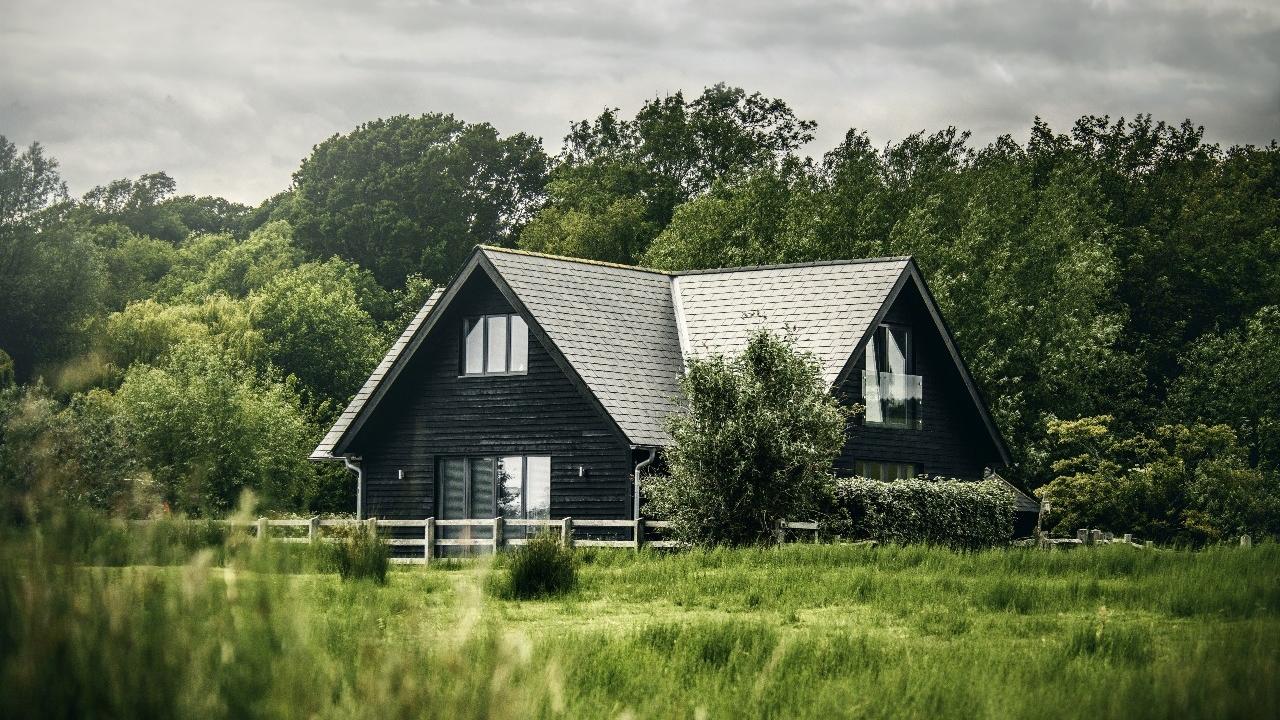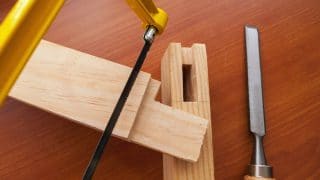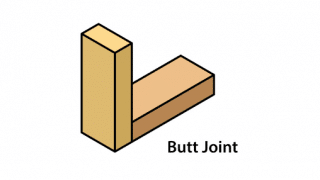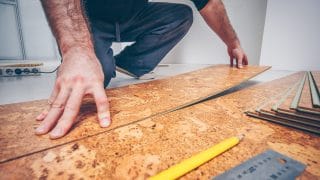
One of the five types of foundations common in the U.S., wood foundations have been built for hundreds of years. In the middle of the 20th century, however, a new type of wood foundation emerged—the permanent wood foundation, or PWF. It uses pressure treated wood to create foundations that are resistant to both rot and damage from insects. PWFs can, however, lead to surprisingly heated discussions among architects and builders who have strong opinions about when or even if wood foundations are a good choice.
What Is a Permanent Wood Foundation?
Though its name might lead you to believe that the entire foundation is of wood, in fact only the below-grade foundation walls of a PWF that are made of wood. The base is typically a concrete slab atop a bed of crushed rock or gravel. The wood used in PWFs is pressure treated with chromated copper arsenate (CCA). The copper part of the chemical treatment provides resistance to mold, fungus, and rot while the arsenate repels ants and termites.
In addition to moisture and insects, a wood foundation must withstand lateral pressures from the surrounding soil as well as environmental loads like wind, rain, and snow, which add pressure onto the foundation. This is usually simply an engineering problem, with the width and spacing of framing members determined by the backfill height.
While treated lumber is resistant to moisture, it is still necessary to waterproof the foundation; use film, fluid applied sealants, caulking, and other materials to create a moisture-proof seal; and also assure proper drainage. Any fasteners used in a PWF also need to be waterproof.
Pros and Cons of Wood Foundations
Though they remain relatively uncommon, PWFs have advantages that make them an option worth considering.
Advantages of Wood Foundations
- Ease of installation. The same crew that is erecting a house’s wood framing can build wood foundations, and in far less time than it takes to build a concrete foundation.
- Advantage in remote locations. PWFs are well suited for hard-to-reach building sites where transporting materials for a poured concrete or concrete block foundation may be impossible.
- Construction timing. While it is more difficult to pour a concrete foundation in wet or cold months, it is easy to erect a PWF in any season.
- Flexibility. It is easier to move a wooden foundation wall than a concrete one if, after construction, the owner decides to alter the house’s floor plan.
- Plumbing and electrical repairs are easier. If you need to access wiring or a pipe, a wooden foundation offers less of an obstacle than a concrete one.
- A green choice. Since PWFs use a renewable resource—wood—they are arguably greener than concrete foundations.
- Insulation benefits. Another green advantage of a wood foundation is that it creates a warmer basement, lowering heating costs.
Disadvantages of Wood Foundations
- Damage from rot and insects. If a wood foundation is properly built and the site is well-drained, a PWF can last for decades. Not everything always goes to plan, however, and if moisture seeps in or the insect resistance of treated wood fails, replacing portions of a wood foundation may be costly.
- Expense. Wood foundations are generally more expensive to build than those from concrete, a relatively cheap material, or those without basement living space, such as stem wall foundations.
- Novelty of PWFs. While hundreds of thousands of houses have been built in the United States with PWFs, concrete foundations, whether poured or made of blocks, remain the norm. From home inspectors to realtors, owners of PWF houses may face some skepticism and additional hurdles—as when getting their home insured, to pick one example.
- Toxicity of materials. The chemicals used to pressure treat the wood used in PWFs require the use of protective gear during construction (true of all pressure treated wood), and many homeowners are concerned about possible health and environmental dangers.
Learn all about the properties of wood and how wood is used in construction in the MT Copeland course on Wood Materials. Taught by professional builder Jordan Smith, the course covers topics that range from wood hardness and shear strength to joists and laminated veneer lumber.
One of the five types of foundations common in the U.S., wood foundations have been built for hundreds of years. In the middle of the 20th century, however, a new type of wood foundation emerged—the permanent wood foundation, or PWF. It uses pressure treated wood to create foundations that are resistant to both rot and damage from insects. PWFs can, however, lead to surprisingly heated discussions among architects and builders who have strong opinions about when or even if wood foundations are a good choice.
What Is a Permanent Wood Foundation?
Though its name might lead you to believe that the entire foundation is of wood, in fact only the below-grade foundation walls of a PWF that are made of wood. The base is typically a concrete slab atop a bed of crushed rock or gravel. The wood used in PWFs is pressure treated with chromated copper arsenate (CCA). The copper part of the chemical treatment provides resistance to mold, fungus, and rot while the arsenate repels ants and termites.
In addition to moisture and insects, a wood foundation must withstand lateral pressures from the surrounding soil as well as environmental loads like wind, rain, and snow, which add pressure onto the foundation. This is usually simply an engineering problem, with the width and spacing of framing members determined by the backfill height.
While treated lumber is resistant to moisture, it is still necessary to waterproof the foundation; use film, fluid applied sealants, caulking, and other materials to create a moisture-proof seal; and also assure proper drainage. Any fasteners used in a PWF also need to be waterproof.
Pros and Cons of Wood Foundations
Though they remain relatively uncommon, PWFs have advantages that make them an option worth considering.
Advantages of Wood Foundations
- Ease of installation. The same crew that is erecting a house’s wood framing can build wood foundations, and in far less time than it takes to build a concrete foundation.
- Advantage in remote locations. PWFs are well suited for hard-to-reach building sites where transporting materials for a poured concrete or concrete block foundation may be impossible.
- Construction timing. While it is more difficult to pour a concrete foundation in wet or cold months, it is easy to erect a PWF in any season.
- Flexibility. It is easier to move a wooden foundation wall than a concrete one if, after construction, the owner decides to alter the house’s floor plan.
- Plumbing and electrical repairs are easier. If you need to access wiring or a pipe, a wooden foundation offers less of an obstacle than a concrete one.
- A green choice. Since PWFs use a renewable resource—wood—they are arguably greener than concrete foundations.
- Insulation benefits. Another green advantage of a wood foundation is that it creates a warmer basement, lowering heating costs.
Disadvantages of Wood Foundations
- Damage from rot and insects. If a wood foundation is properly built and the site is well-drained, a PWF can last for decades. Not everything always goes to plan, however, and if moisture seeps in or the insect resistance of treated wood fails, replacing portions of a wood foundation may be costly.
- Expense. Wood foundations are generally more expensive to build than those from concrete, a relatively cheap material, or those without basement living space, such as stem wall foundations.
- Novelty of PWFs. While hundreds of thousands of houses have been built in the United States with PWFs, concrete foundations, whether poured or made of blocks, remain the norm. From home inspectors to realtors, owners of PWF houses may face some skepticism and additional hurdles—as when getting their home insured, to pick one example.
- Toxicity of materials. The chemicals used to pressure treat the wood used in PWFs require the use of protective gear during construction (true of all pressure treated wood), and many homeowners are concerned about possible health and environmental dangers.
Learn all about the properties of wood and how wood is used in construction in the MT Copeland course on Wood Materials. Taught by professional builder Jordan Smith, the course covers topics that range from wood hardness and shear strength to joists and laminated veneer lumber.
Choosing a Wood Foundation: considerations
Much of the appeal of a PWF is the warm and inviting wood basement living space it offers. If the plans for a house don’t include a basement (as in the case with most new home construction in many parts of the country—much of the South, Texas, and California, for example, where flood risk makes pier-and-beam foundations a popular choice), then this advantage of a PWF isn’t relevant.
A PWF may also not be suited to your particular site if the soil doesn’t drain well or it is in an area with a high water table.
If environmental factors don’t eliminate a PWF as an option, then it is a matter of weighing some of the pros and cons above. These questions will help you assess if a wood foundation is a good fit:
- How likely is it that the owners will want to adjust the floor plan of their house over the long term?
- Are they willing to pay a premium to build an arguably greener home?
- Will the choice of foundation impact the construction schedule?
MT Copeland offers video-based online classes that give you a foundation in construction fundamentals with real-world applications. Classes include professionally produced videos taught by practicing craftspeople, and supplementary downloads like quizzes, blueprints, and other materials to help you master the skills.







